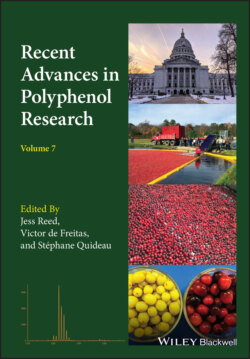Читать книгу Recent Advances in Polyphenol Research - Группа авторов - Страница 19
1.4 The Kinetic Processes
ОглавлениеScheme 1.5 represents the four kinetic processes of anthocyanins and related compounds in acidic medium. It is worth noting that, like in the case of the formation of the quinoidal base from flavylium cation, all the other anionic species are formed as in Scheme 1.3, from proton transfer. This reaction represents step 1 in the kinetic process and takes place in microseconds during the mixing time of the stopped flow. Only using special techniques such as temperature jumps (Brouillard and Dubois 1977), and in some favourable cases flash photolysis, are these constants obtained.4 This fact makes the kinetics reported in Scheme 1.5 the only relevant ones upon direct pH jumps, since the formation of the anionic species is immediate when compared with hydration, tautomerization, and isomerization. Moreover, the first process after a direct pH jump (from flavylium cation) is the formation of the quinoidal base, which equilibrates with the flavylium cation. In the subsequent kinetic steps these two species behave as a single one.
Scheme 1.5 Energy level diagram of the relative thermodynamic level of the five species of pelargonidin‐3‐glucoside appearing in acid medium. The three distinct kinetic steps taking place in very different time scales are observed, allowing for separation of the kinetics into three kinetic equations.
The following kinetic step is the hydration followed by tautomerization (Scheme 1.5). Except in very acidic solutions (not accessed by direct pH jumps), the tautomerization reaction is faster than hydration and by consequence this last one is the rate‐determining step of this kinetic process. This kinetic step can thus be considered as in eq. (39).
During the hydration both AH+/A and B/Cc can be considered as a single species.
(39)
where XAH+ is the mole fraction of AH+ in its equilibrium with A, and XB is the mole fraction of A in its equilibrium with Cc.
In eq. (39) the forward reaction takes place only from the reaction of AH+ to form B, because, as mentioned above, the quinoidal base A does not hydrate in acidic medium (Brouillard and Dubois 1977).
For anthocyanins and many of the flavylium derivatives, the last step is controlled by the isomerization of chalcones, which is by far the slowest process of the kinetics. A similar reasoning used for step 2 can be made for step 3. In this case all species except Ct can be considered equilibrated.
(40)
